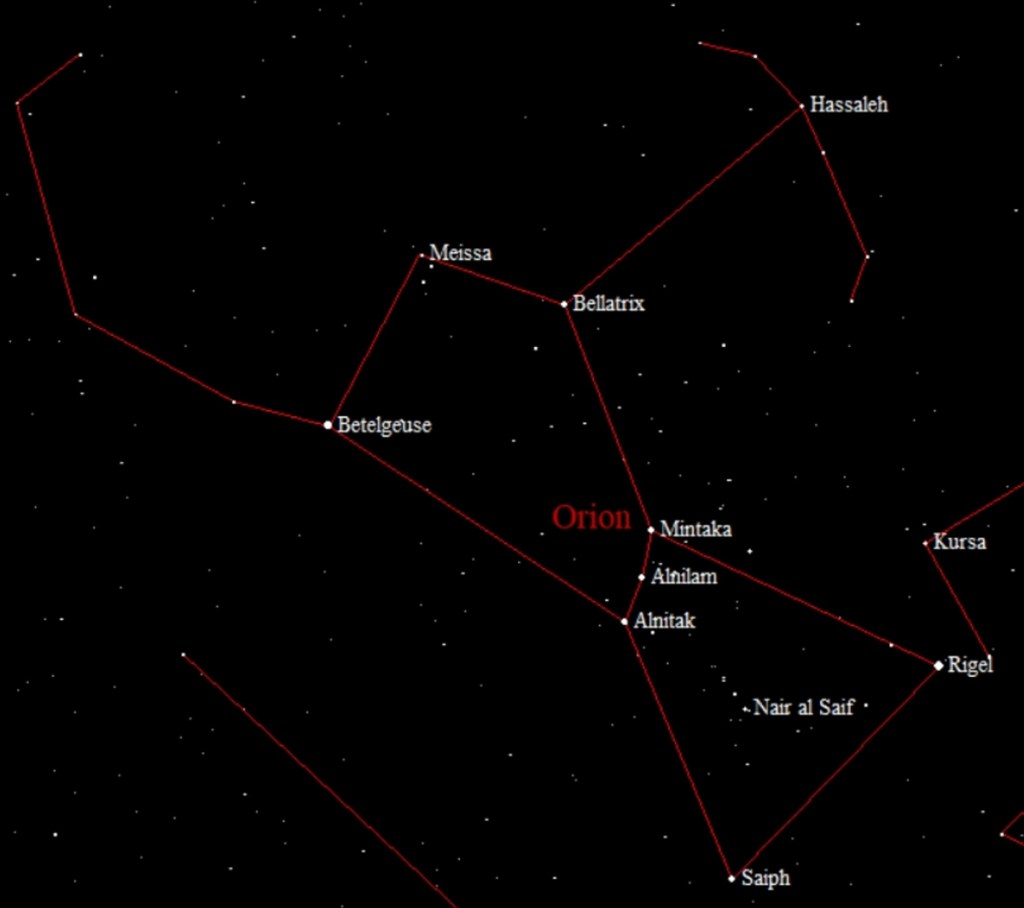One of the most recognizable constellations is bright in the southwest at early evening this time of year, Orion. He always comes up sideways, as Robert Frost pointed out 100 years or so ago, and climbs across the southern sky with his bow or shield directed westerly. A row of three bright stars in the midsection looks like a belt, and three lights below seem to form a sword hanging from it. The second-brightest star in the constellation is at the top, where your eye kind of fills in the figure’s head, though this is traditionally pictured as his back shoulder. At the bottom is a slightly brighter star, where your eye wants his feet to be.
All these stars, naturally, have names. I say “naturally,” which really could mean a lot of things, because humans have been naming everything, including stars, since time immemorial, an activity that is nowhere near as simple and straightforward as it seems.
Take, for example, the star names in Orion. The bright star at the shoulder is the red giant Betelgeuse; at the feet is the white supergiant Rigel. The three stars in the belt, from left to right, are Alnitak, Alnilam and Mintaka. In Orion’s leading shoulder, somewhat dimmer than Betelgeuse, is Bellatrix. Dimmer still, above Betelgeuse and Bellatrix, where you might picture Orion’s head or face, is Meissa.
Strange-sounding names. Where do they come from, and how do the astronomers settle on them?
Well, it’s no surprise that most bright stars’ names have ancient origins. But interestingly, many star names are still being fixed. Alnitak, Alnilam and Mintaka, for example, are so prominent that it would seem safe to assume their names have been standard among Western astronomers for a long time. But in fact, those three names were officially accepted by the International Astronomical Union only about two years ago. The IAU was formed in 1919 by professional astronomers as the world’s central, guiding astronomy group. One of their projects is to sort out, streamline and standardize the naming of stars and other celestial bodies, such as moons and dwarf planets.
Stars are “named” and “designated.” Naming refers to common proper names, like Betelgeuse, Rigel and Alnitak. Designating refers to numerical labels associated with catalogs of stars. Star catalogs go back to ancient times, but up to the 20th century they’ve been far from standardized — meaning each bright naked-eye star has been called a lot of different names by different cultures and even within cultures.
Estimates vary, but something like 6,000 individual stars are visible to the human eye from Earth. Of those 6,000, the IAU recognizes common names for 313 of the brightest ones. Many of the oldest traditional names are derived from Greek and Latin from before 500 A.D., some of which have more ancient Egyptian and Babylonian backgrounds. By about 1000 A.D., Islamic scientists and philosophers were influencing higher learning of all kinds in Europe, especially astronomy, and Arabic star names were widely used in Europe. Alnitak is an example of a name applied from an abbreviation of a pre-500 B.C. indigenous Arabic phrase for the belt we call Orion’s.
The development of the scientific method during the European Renaissance drove a need for systematic cataloging. In 1603 Johann Bayer published his “Uranometria,” in which the brightest stars in each constellation are designated by Greek letters. Within a few years telescopes started being turned skyward regularly, revealing thousands more individual stars, and so naming and designating became even more difficult problems. In the 1700s John Flamsteed assigned numbers to bright stars according to their positions in their constellations. The Bayer and Flamsteed designations are still basic identifiers today. As telescopes became stronger, the number of distinguishable stars, well, skyrocketed, and now astronomers use a whole array of catalogs of numerical designations, among them the Yale Bright Star Catalog, the Smithsonian Astrophysical Observatory Star Catalog, and the Henry Draper Catalogue. So Betelgeuse, whose common name is the end result of centuries of conflations, misspellings and misreadings of ancient Arabic and Greek words, is designated in these catalogs as, respectively, HR2061, SAO113271 and HD39801.
There are somewhere in the neighborhood of 200 billion stars in the Milky Way galaxy. In December, the IAU added 86 names to its list, to bring the number of officially accepted names to 313.
Among those is the brightest star in Orion’s sword, designated HR1899 in the Yale Bright Star Catalogue, 45 Orionis by Flamsteed number, and Iota Orionis by Bayer’s Greek letter system. My Earth Centered Universe software program names it Nair al Saif, meaning “the Bright One in the Sword,” as do the reference guide “Starlist 2000” and James Kaler’s “Stars” website. The newly authorized IAU name, however, is Hatysa. Where did that come from?
Well, a Czech astronomer, Antonin Becvar, in the mid-20th century compiled and published a star map called the Atlas Coeli Skalnate Pleso. Astronomers trusted Becvar’s work, and names and designations in the maps were reproduced in other star publications. After a while it was noticed that some of the Atlas Coeli star names were strange. After Becvar’s death in 1965, scholars dug into the origins of the strange names, but could not figure them out. One of the 12 names that scholars say is completely unexplainable is Becvar’s name for the brightest star in Orion’s sword, which other authorities know as Nair al Saif — Hatysa. Even its spelling varies as Hatsya.
It would be interesting to know whether Becvar viewed names as simply labels, or if he thought, like some of us in the humanities, that names carry far deeper energies — suggesting, maybe, that he knew things we don’t about Hatsya.
We’ll never know, I guess. But if you think names are just whimsies, you can go on the internet, buy one and name your own star. The IAU does not recommend it, however. Some bridges are for sale cheaper.
Send questions/comments to the editors.



Comments are no longer available on this story